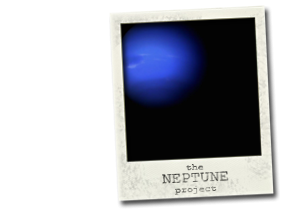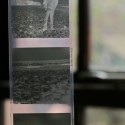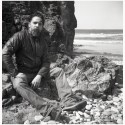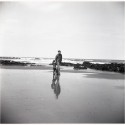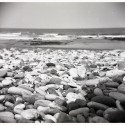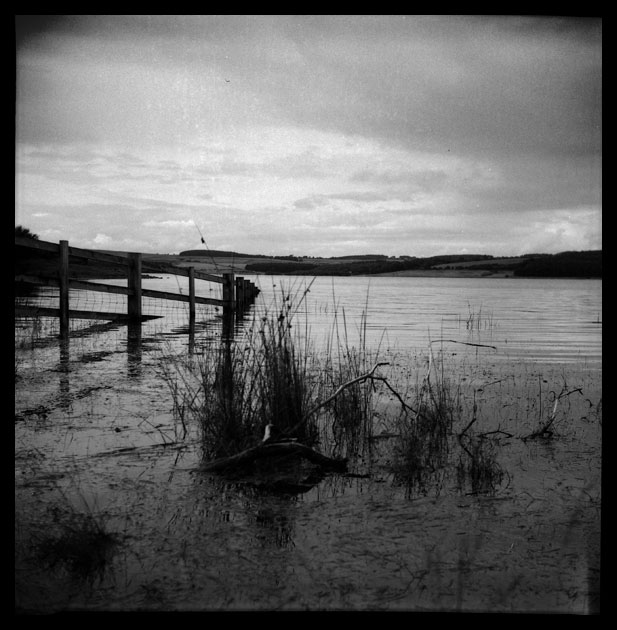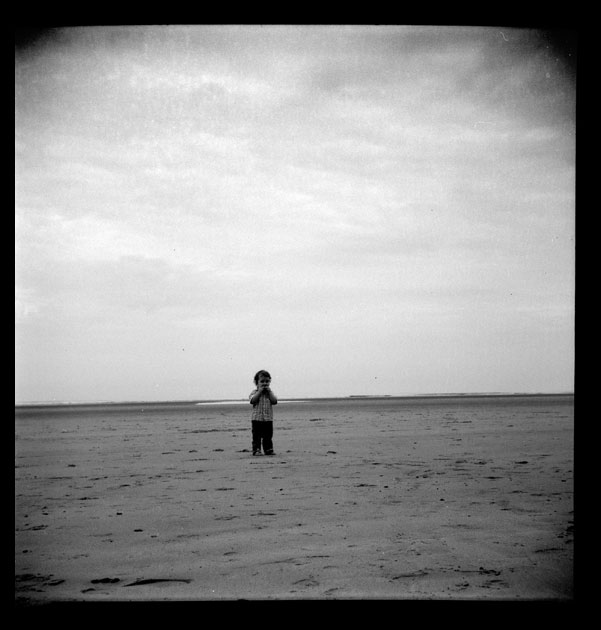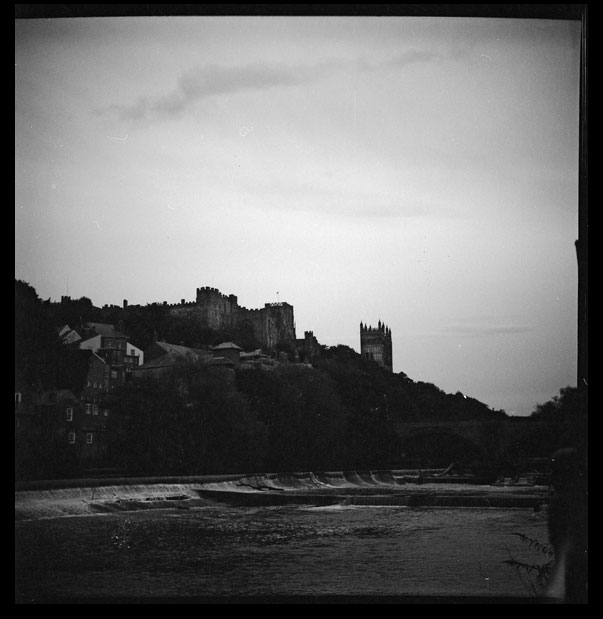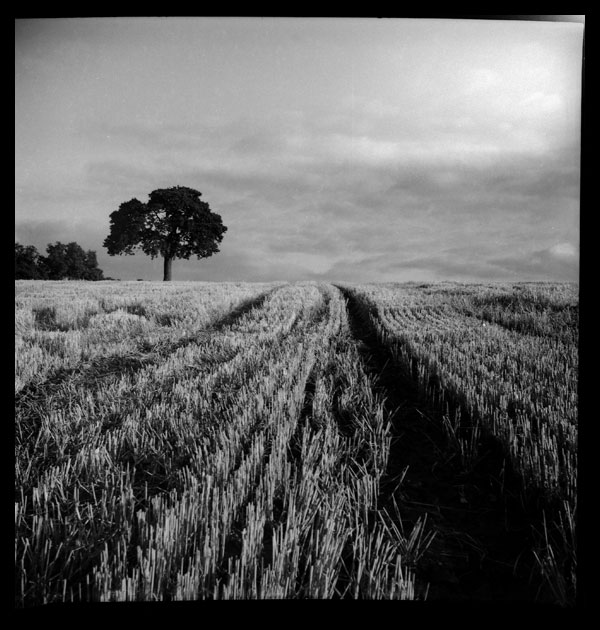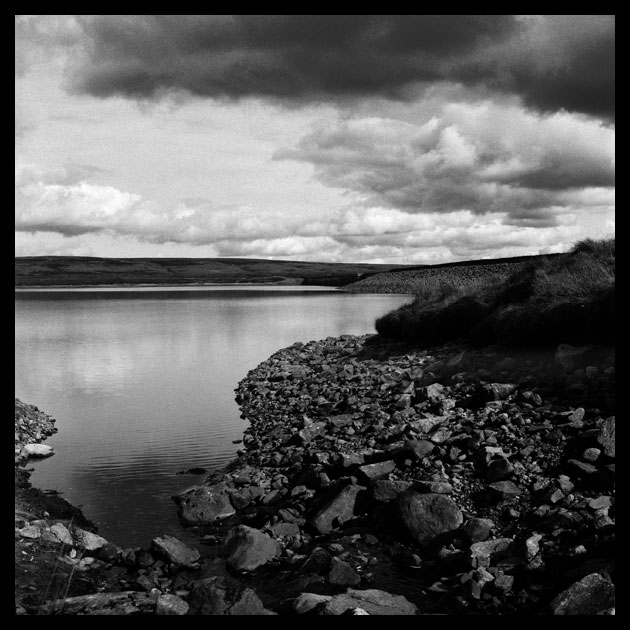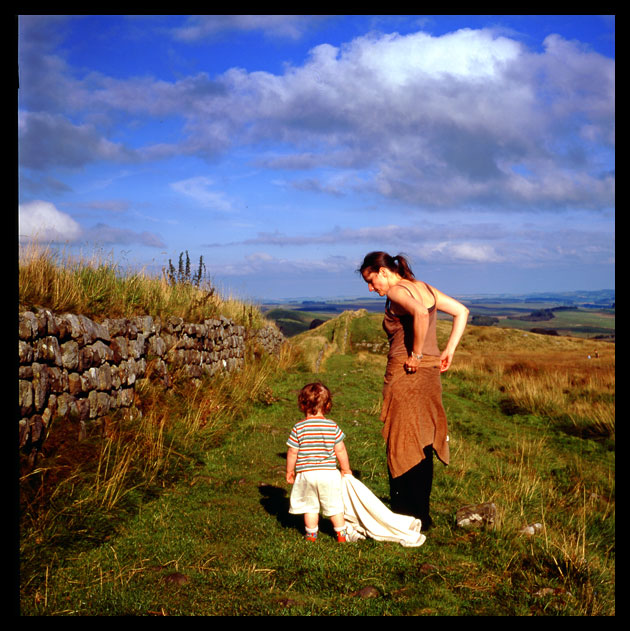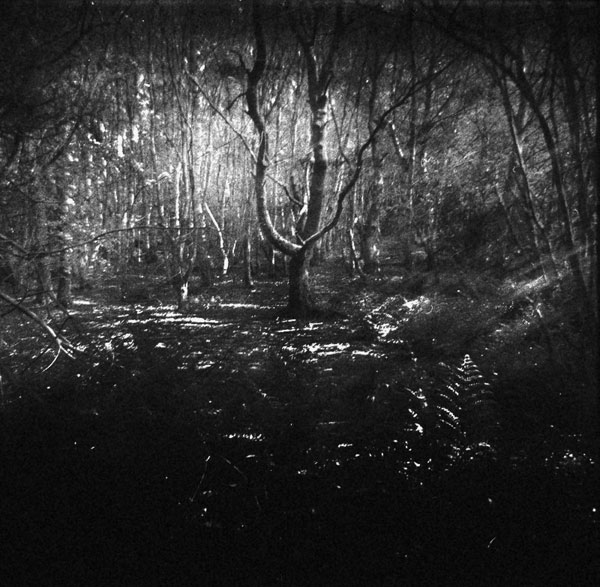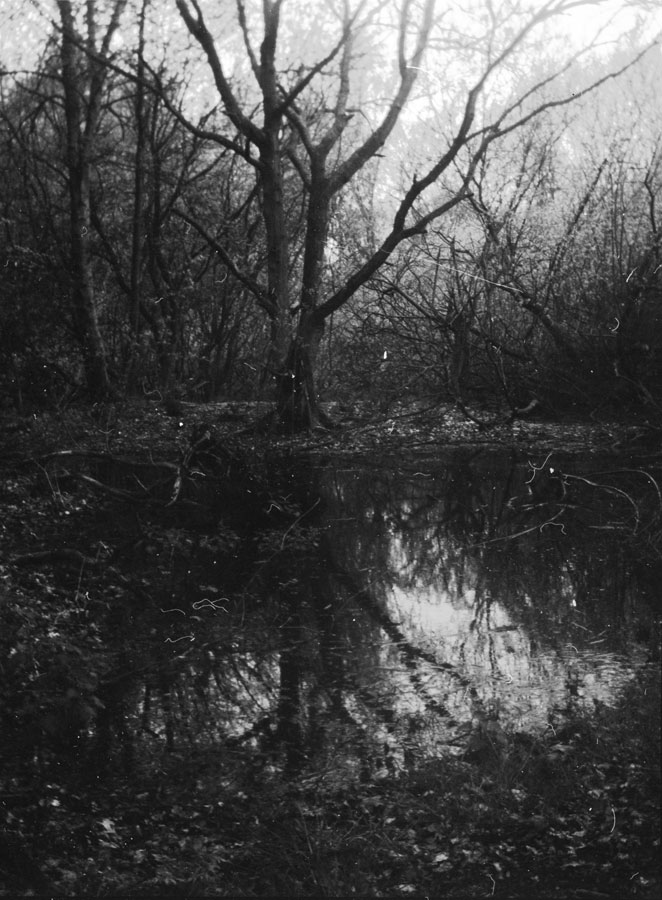I received a really rather fabulous Christmas present this year. And the fact that it is now May is evidence of how long it took me to get around to trying it out.
See, it’s been a long while dormant, this blog, whilst life’s turbulences have buffeted us about a bit around here. But it never truly died. Jem has been solidly carrying on with it all, whenever he could, but my mojo… well… let’s just say it’s just returning.
A couple of lovely women have been instrumental in firing me back up – one on Instagram and one on Twitter – both of whom have a similar passion, and talking about it with them brought it all burning and rushing back to the surface.
So, without further ado, what better camera to reintroduce the analogue into my life than this little beauty (click pictures for undistorted view):
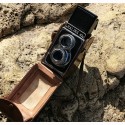 In all its beauty, sunbathing at Blackhall Rocks.
In all its beauty, sunbathing at Blackhall Rocks.
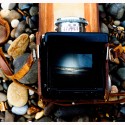 And here, through the viewfinder.
And here, through the viewfinder.
It really was a fabulous find – still in its original box, its original leather case. It is a stunning little TLR, but you can’t take things for granted, so I loaded it up and took it through its paces. Quickly. And without much regard to what I was photographing. Little worse than putting a lot of effort into it, only to find once you’ve processed the film that it has terrible light-leaks or the shutter is broken or… you get the idea.
Anyway, I brought it home and processed the film right away, and it worked!
And here is the *in most cases not terribly impressive but oh-my-gosh look how it works* evidence ![]()
View from Roseberry Topping
no image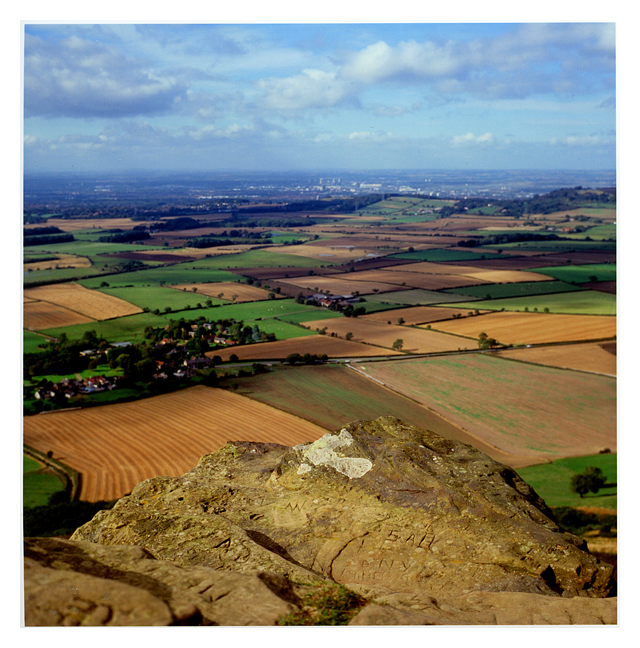
“View from Roseberry Topping”
Yashica 124G / FUJI RVP100F
This is a scan from a print from a roll of slide film. As you can imagine, it barely does it justice. It’s a helluva climb up here, and that’s without carrying a half ton toddler!
Dusk at Cow Green
no image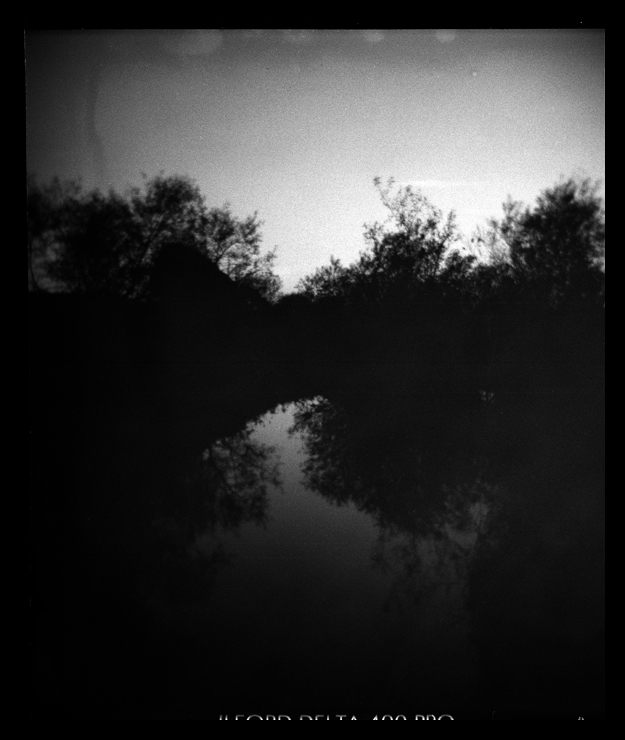
“Dusk at Cow Green.”
Holga 120FN / Found Ilford Delta 400
Hibernation over, the sun is shining. Lots of film processing, plenty more to shoot. This is from a Russian plastic Holga, they give a lovely feeling.
Dunstanburgh III
no image“Dunstanburgh III”
Yashica 124G / Ilford Delta Pro 100
This is the last of the Dunstanburgh pictures from the Yashica. I processed another roll of Ilford last night, this time from the Lubitel 166. I am going to the Cleveland Hills today, in Yorkshire with the Yashica, the Superheadz and a Werra. It’s a beautiful day.
Brownie Flash III on Fuji Acros 100
no imageThere isn’t an outing in this house that doesn’t involve at least four cameras each (per adult) and one each for at least three of the children… That’s a *lot* of cameras…
And there’s a danger with this modus operandi: one tends to forget which camera does or doesn’t contain film.
I had assembled my photographic equipment for our walk the other day: my Halina Paulette, Bencini Comet IIS and my Lomo Lubitel 2, when another appeared on my ‘pile’ – a Brownie Flash III. I asked Jem if he’d put it there and he told me he’d noticed it had a ’4′ in the red window. Eek! That meant it had film in it and I had no recollection whatever of when or where I had loaded it and taken the first four shots. The only thing I did know (because it was another of our ‘live and learn’ moments) is that it was loaded with Fuji Acros 100… because I had put a sticker on the bottom of it saying so.
So, now that we’re up and running with our own developing, it seemed prudent to finish the film as quickly as possible and get it processed.
Of the mere eight shots that a roll of 120 yields from a Box Brownie, only four and a bit really came out. Despite the fact that the camera had been stored in its original canvas case, the film had still deteriorated and there’s serious fogging throughout, totally destroying two shots, making the third unusable, but the other five came out with varying degrees of success.
My lessons for today, then, are:
- Remember which camera is loaded.
- Make sure you use it till it’s done.
- If you store it for a while without using it, make sure you cover the red window with electrical (or similar) tape.
One of them, however, came out beautifully in spite (or maybe because) of the deterioration. One of our favourite photographic spots:
The Anchor Brewery
no imageViewed from St. Benedict’s in Norwich
Kodak Duex / Fuji Pro
This shot was mostly an experiment taken with the 1940 Kodak Duex, I was keen to see what it would do with some high-saturation colour film in it. I have discovered that it only really likes somewhat distant subjects (over 8 feet) and good light.
Bullards ceased beer production in 1966 and the impressive edifice is now home to an insurance company. Now that’s dissonance!
1938 Voigtländer Brilliant
no image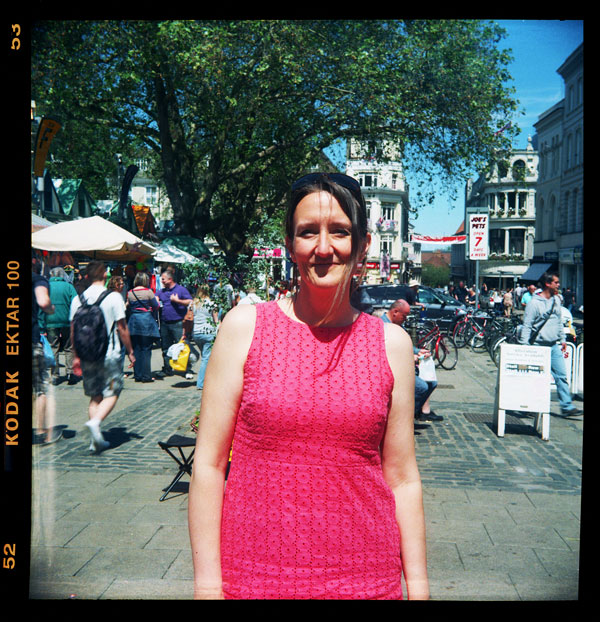 There has been quite a saga accompanying this camera. The Voigtländer Brilliant of 1938 was the world’s first focusing TLR, and as a template it has spawned several copies, most notably the Lomo produced Lubitels (of which we have two), but even if the copies are great – for reasons of lomography – they don’t quite have the pedigree of the Voigtländer. I realised after trustingly putting a roll of Ilford through it that the focusing mechanism was off kilter, so I resolved to try it again using zone focus and a roll of Ektar.
There has been quite a saga accompanying this camera. The Voigtländer Brilliant of 1938 was the world’s first focusing TLR, and as a template it has spawned several copies, most notably the Lomo produced Lubitels (of which we have two), but even if the copies are great – for reasons of lomography – they don’t quite have the pedigree of the Voigtländer. I realised after trustingly putting a roll of Ilford through it that the focusing mechanism was off kilter, so I resolved to try it again using zone focus and a roll of Ektar.
It has taken a while to get the camera this far. I bought it very cheaply last year and like all of the Brilliants, it hadn’t aged especially well. The finder was loose and rusted, the mirror had lost nearly all its silver, the film chamber’s painted interior was flaky and the counter wouldn’t move. I cut a new mirror and replaced it then set to work drilling out the rusted screws from the finder. I carefully removed the prism finder and put it out of the way: it’s a beautiful and precise piece of glasswork after all, then a few moments later heard a crash. I looked up to see that one of the boys had decided to have a look at this rather gleaming jewel, picked it up and promptly dropped it on the floor.
Even though I immediately recognised this as an excellent opportunity to practise mindfulness, I was still devastated. The entire corner of the prism was smashed and at first glance it looked as though the camera was going to have to go for spares.
In the end I cleaned it all up and put it back together anyway and found that because the finder hood covered a good portion of the prism, it was still in fact usable. I wasn’t able to fix the focus because the viewing lens was moving freely through its range in tandem with the taking lens, there was nothing to adjust. For some reason, it just doesn’t match up anymore. I suspected that this might be because the infinity stop had shifted but I checked the film plane for accuracy and it seemed good. So I loaded up some Ektar and took it to Norwich with me at the weekend.
The reason that focusing Brilliants with good glass are so desirable is not so much the focusing ability of the camera, but the quality of the Skopar lens. It operates at a very decent ƒ3.5, and is reputed to have excellent characteristics. The vast majority of surviving Brilliants have much less capable lenses than the Skopar.
Upon seeing a few of the results, I have to agree. This camera takes a great deal of patience to use, it is after all 74 years old now, and has taken a few knocks, both old and new, but it is still a classy performer all the same, as you can see.
Even so, I think I shall be selling it. Even without a focusing viewing lens, a partly smashed prism and a non-functional film counter I think I can get a decent price for it because the lens is gold, and as any serious photographer will tell you, the lens is pretty much the whole story, regardless of its innate style. I love plastic lenses, which cost a few pence, but they give a very different style. If you are looking for accuracy, then the Skopar beats many more modern competitors hands-down.
Plus, I recently bought a Yashica from Pakistan and I cannot really justify owning five TLRs!
Ensign Ful-Vue Super in Monochrome
no imageAfter the roaring success of the Ful-Vue Super in colour (Ektar, to be precise), I decided to give it a go in black and white. So I filed down a roll of Ilford HP5 120 film to fit (it being a 620 medium format camera), loaded it up and off I went. (Home-developed in Ilford LC29 and home-scanned).
The results can be found here. But here are one or two to be going on with:
The only problem I had is that once again it began sticking and slipping at around exposure 4, and by number 10 I had to give up winding on, so I have lost 2 shots per roll so far. And on a roll of film that only contains 12 exposures anyway, that’s a pricey fault!
I suspect that the culprit is the filed down 120 film. 120 comes on a much thicker spool and I don’t think the more streamlined mechanism is coping with it at all well, so for the next roll, I’m going to have to attempt respooling 120 film onto a 620 spool. I am assured that once you’ve got the hang of it there’s really nothing to it…
*gulp*
![]()
Wish me luck!
A Tribute to Alice
no image Here is a shot of Alice from a roll of HP5 taken with the Kodak Brownie Six-20 model D, of which I have two copies procured from a local antique shop, neither costing more than the price of a lifestyle coffee in the city.
Here is a shot of Alice from a roll of HP5 taken with the Kodak Brownie Six-20 model D, of which I have two copies procured from a local antique shop, neither costing more than the price of a lifestyle coffee in the city.
Alice is a great photographic subject, which somebody pointed out to me yesterday. It is not that I’m unaware of how strong and refined she is. Her calm, poise and her peaceful nature are easy to get used to, but they sometimes really show in a photograph too.
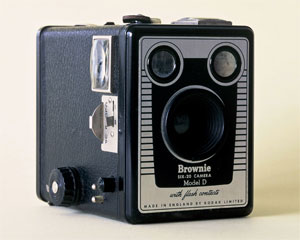 I will put up a few more shots from this roll later. It is remarkable to consider that the camera is several decades old and hasn’t even been particularly valued or cared for in most of that time. I have much more expensive and high-end cameras than this but even so, they can’t compete with some of the old-timers for sheer style and elegance.
I will put up a few more shots from this roll later. It is remarkable to consider that the camera is several decades old and hasn’t even been particularly valued or cared for in most of that time. I have much more expensive and high-end cameras than this but even so, they can’t compete with some of the old-timers for sheer style and elegance.
A bit like Alice in fact.
Bencini Comet IIS loaded with 35mm Fujicolor C200
no imageOnce again, a steep learning curve ![]()
It wasn’t until I’d developed the film that I realised how much of the shot you lose to the top and bottom when shooting 35mm in a 127 medium format camera. So I’ve lost heads and feet… But, fortunately, most of the shots I took were either landscapes or far enough away not to be too significant.
This was a seriously fun experiment.
I’ll talk you through it.
I started off with a dark-bag, a canister of 36 exp Fujicolor C200 film, a 127 spool and used roll of backing paper, scissors, an empty plastic film canister, and a length of string with which to measure the amount of film I needed for the roll. I had already marked the backing paper with masking tape where the film needed to begin and where it would end and, in the dark-bag, I used that tape to fix it to the backing paper. I opened the canister, used the string to measure out the amount I needed, cut it off the rest of the roll and put the remainder into the black plastic film pot (which I marked with its contents). Then I fixed it, as mentioned, to the backing paper and wound it on to the spool. Which is all jolly good fun and gives a whole new lease of life to the expression ‘fumbling in the dark’.
Once it was wound really tight, I could use a little more masking tape to secure it, and then it was ready to load into the camera. A friend-in-the-know (that’s you, Juliet) mentioned that, since the 35mm is a more sensitive film, you need to cover the red window with some dark tape (I used electrical tape) and peel it back in subdued lighting in order to wind the film on to the next frame. This worked well.
Here are a couple of the shots (you can find the rest here and, for the sake of a laugh, if nothing else, I have included the headless shots ![]() ):
):
Bencini Comet II S and Rollei 80s Retro 127 film
no imageWell, you live and learn. ![]()
I got ridiculously excited about this camera partly, I suspect, because it is *so* beautiful. Bright and shiny and small, with smooth motion and very simple mechanisms. But each time you use a new camera you are, of course, unaware of its capabilities or limitations.
This camera and film combination, I have discovered, is not much good for taking pictures of people. But photographs of architecture, under the right conditions, can be lovely. The lens on my copy is not very sharp, nor the focusing very accurate or easy, but I suspect that beautiful results could be achieved with a rich colour film and some woodland / countryside.
Out and about in Norwich yesterday, I saw this chalkboard and the one in the shop window and thought them rather charming. This, I believe, is one of the shots that came out best.
This one, too, I liked, of the Belgian Monk and the church next to it.
The rest of the roll can be found here.
I have just done something that felt rather brave and risky. In a dark bag, I spooled some 35mm film onto a 127 spool and backing paper, and I’ve loaded it into the Comet. Another experiment in the offing… ![]()
Ensign Ful-Vue Super - the results are in!
no imageI wrote about the Ensign Ful-Vue before. In short: saw it, loved it, used it, was totally underwhelmed by the results.
 Then Jem surprised me with an Ensign Ful-Vue Super; a slimmer, smaller, more streamlined version with a twisting focusing lens and viewfinder cover. Whilst I appreciated its obvious beauty, I’d been seduced and disappointed by its predecessor, so I approached this one with a little more reticence. I filed down a 120 roll of Kodak Ektar to fit, as it takes 620 film, loaded it up and off we went.
Then Jem surprised me with an Ensign Ful-Vue Super; a slimmer, smaller, more streamlined version with a twisting focusing lens and viewfinder cover. Whilst I appreciated its obvious beauty, I’d been seduced and disappointed by its predecessor, so I approached this one with a little more reticence. I filed down a 120 roll of Kodak Ektar to fit, as it takes 620 film, loaded it up and off we went.
The only real problem I encountered is that the take-up spool began slipping before I was halfway through the film. By exposure 10 neither gentle persuasion nor brute force was going to budge it. Since it was loaded with Ektar and we haven’t got as far as home-developing colour film yet, we were taking it to the shop for a develop only, and I was tasked with removing it from the camera and putting it in a light-tight case inside a dark-bag at the shop counter. This, I discovered, was a very different experience from the privacy of my own kitchen table! Thankfully, it went without a hitch, and when we examined the camera afterwards, it was quite obvious that the pins that turn the take-up spool have bent upwards and are no longer gripping effectively. Jem assures me this won’t take much to fix. ![]()
So home we went to scan our films and I was incredibly happy with the results.
This is the portrait I attempted, bright sun outside, in our bedroom window, my eldest son. The tones, colours and sharpness were a real surprise. I should add that I don’t believe it has a light-leak, in spite of the fact that this exposure appears to have one. Rather, I believe I left the counter window open in bright sunlight, which has flooded this shot somewhat. Oops! You live and learn, eh? ![]()
And here is an example of how well it works in a sun-flooded room:
It also has a lovely quality when photographing buildings:
You can find these and some other shots from the roll here.
The Dream Tree
no imageTaken last week.
Kodak Cresta II (1956) / Cross-processed XP2
Ensign Ful-Vue - or - don't judge a camera by its looks...
no imageI’ve come to a realisation lately. I have been seduced, endlessly, by the beauty of old cameras, but the truth is a universal one:
Don’t judge a camera by its looks. ![]()
I have been disappointed by two notably: The Kodak Brownie Reflex 20 and the Ensign Ful-Vue. The fact is that they have utterly stunning viewfinders but the end results – the shots themselves – are totally underwhelming. If a photograph looked like its image in the viewfinder, if the judging of the camera were that simple, wouldn’t we all be incredible photographers!
The Ensign Ful-Vue has possibly the most beautiful viewfinder I’ve yet seen. I was wildly optimistic when I took it for its test run, and I restored it lovingly before I had seen the results, the best of which I am posting here.
Conversely, the Halina Paulette, which looks a little like a toy camera and has an innocuous and unconvincing shutter sound, not to mention the most pathetic little viewfinder which has no bearing on the lens either (manual focus according to distance from subject), can produce some stunning results.
So… the moral of the story?
Well, actually, there isn’t one! The Lomo Lubitel2 has a beautiful viewfinder and produces gorgeous results, so… at best the moral is: don’t be attached to the results – just suck it and see. ![]()
Lo-Fi
no image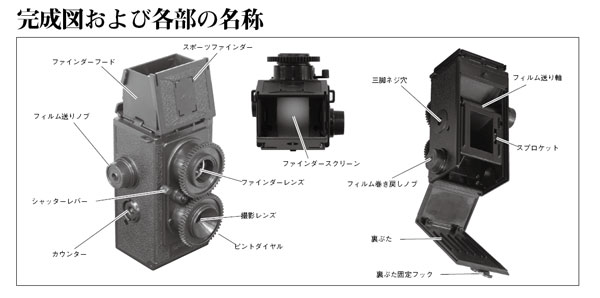 The more cameras I use, the greater my respect for lo-fi photography as a truly viable pursuit. Composition remains true regardless of the lens, and I love the Neptune end of the photographic polarity. That is of course photography’s natural state: chemical uncertainty. The rush to the wrong end of the polarity, toward Virgo and ever greater control, more megapixels, less chromatic aberration, instant verifiable results with the inconveniences cloned out after the fact in Photoshop is getting photography backward.
The more cameras I use, the greater my respect for lo-fi photography as a truly viable pursuit. Composition remains true regardless of the lens, and I love the Neptune end of the photographic polarity. That is of course photography’s natural state: chemical uncertainty. The rush to the wrong end of the polarity, toward Virgo and ever greater control, more megapixels, less chromatic aberration, instant verifiable results with the inconveniences cloned out after the fact in Photoshop is getting photography backward.
Recently I bought a Gakkenflex (pictured) which came originally from Japan. When first made this 35mm ‘Toy-TLR’ retailed for about 6 or 7 dollars, and was made entirely of plastic from a kit in a magazine. There are clones out there which give the same result for not much more. I also bought a Japanese Superheadz Black Devil and I took them both out today along with a 1956 Kodak Cresta II. There is simply no hope of controlling outcomes with any of these cameras, except in the most rudimentary terms. All you have is composition, and an understanding of which light will work, and which won’t.
And that is exactly what makes lo-fi photography so much fun, it has all the magical promise of uncertainty.
Ensign Ful-Vue
no image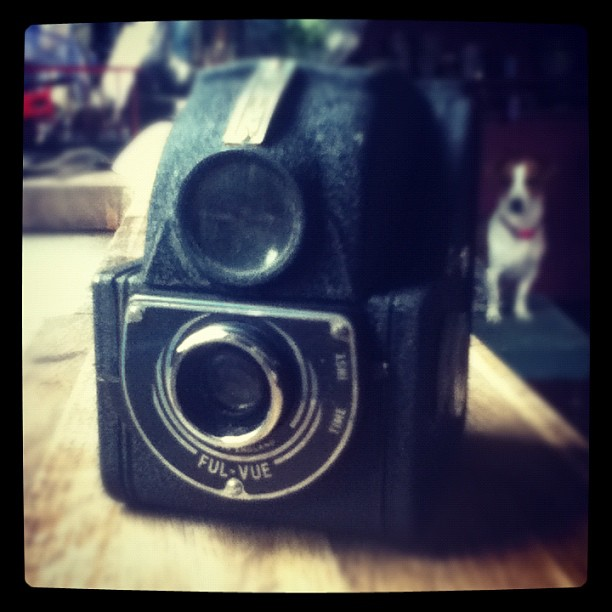 Last week, whilst trawling our local antique (and junk) shops, Jem came across this funky little camera, which he promptly bought for a fiver (“Well… it would have been rude not to!”) and which I promptly fell in love with. My instant love-affair with it meant he gifted it straight to me.
Last week, whilst trawling our local antique (and junk) shops, Jem came across this funky little camera, which he promptly bought for a fiver (“Well… it would have been rude not to!”) and which I promptly fell in love with. My instant love-affair with it meant he gifted it straight to me. ![]()
Yesterday I loaded it up with expired Ilford XP2 film, which is our usual M.O. if we aren’t yet sure if a camera works properly or not, and off we went to try out our very old cameras: Jem was using his Box Brownie for the first time.
This little gem was made between 1946 and 1949. It is a TLR with a beautiful big Brilliant-style reflex viewfinder on the top. It is a unique thing – pretty avant-garde for its time – as it was the first ‘streamlined’ box-style camera of its type. It has a fixed shutter of 1/30th of a second and a fixed aperture of f11. Rather charmingly, if you pull the tiny lens out a little way, you can take close-ups of 3-9 feet, and push it back in for 9 feet or more.
My first hurdle, upon taking it out of my bag for the first shot, was discovering that the mirror has come loose and was rattling around inside the viewfinder compartment. Nothing I can do about that until I’ve finished the roll, so for now I have to give it a gentle shake to reposition it and take my shots *very* carefully…. Of course I can’t be entirely sure it’s back in perfect position either, so there may be some funny angles resulting from this experiment!
I’m halfway through the roll, and hope to have it finished, developed and the results posted up here some time next week.
